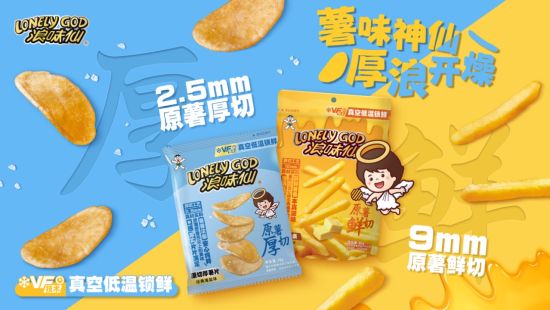Potato-based snacks, which dominate half of the snack market, have always been one of the most competitive categories with frequent product innovations. According to statistics, the preference for potato chip snacks among China’s Generation Z reaches as high as 81.5%. The enduring popularity of potato snacks is closely related to the intense competition among potato snack brands, which compete across flavor, ingredients, processing techniques, and packaging to maintain freshness… When all possible areas have been competed in, how can potato snack brands innovate their products to bring something new and refreshing to consumers?
In the current situation of extreme category diversification, being able to innovate within existing frameworks is already impressive, but being able to think outside the box and create new approaches is truly exceptional. Lonely God, backed by the comprehensive supply chain system of Want Want Group, possesses mature R&D capabilities and production flexibility accumulated over time, which forms the foundation for its continuous innovative breakthroughs. Making its first entry into the mature potato chip and French fry category, Lonely God has created a triple颠覆 in visual, tactile, and taste experiences with its “thick-cut potato chips from whole potatoes” + “fresh-cut French fries from whole potatoes,” once again continuing the brand’s signature potato roll’s multidimensional assault on the mainstream market in the highly competitive potato snack category. This “thick wave” assault not only represents Lonely God’s differentiated approach to entering the potato snack market but also demonstrates beneficial expansion of category innovation boundaries based on consumer insights, showcasing the systematic innovation capabilities of leading companies in category development.

Differentiated external excellence – three cutting methods. “Original cut,” “thick cut,” and “fresh cut” are not just “luxury” choices but also represent entirely new technical challenges. This requires continuous adjustment of slice thickness during R&D to test the optimal balance between substantial texture and crispiness. Thicker potato chips can also deliver a richer original potato aroma. The 2.5mm and 9mm oversize dimensions represent Lonely God’s new interpretation of potato chip and French fry deliciousness. In terms of flavors, the potato chips feature classic sea salt flavor while the French fries come in honey butter flavor as the initial offerings, emphasizing substantial texture and pure taste, representing Lonely God’s unique delicious aesthetic.
High-quality internal excellence – VF technology. Beyond the premium “three cutting methods,” Lonely God’s potato chips and French fries offer even more in terms of quality. They utilize VF vacuum low-temperature frying technology. VF technology (Vacuum Low Temperature Frying) is a food processing technique that combines vacuum environment with low-temperature treatment. In a vacuum environment, the typical frying temperature of 160-200°C can be significantly reduced to 90-120°C. This not only preserves more of the ingredients’ nutrition, color, and natural flavors while creating a fluffy and crispy texture but also reduces oil content by 30%-50% compared to traditional frying methods, avoiding the charring and excessive greasiness associated with high-temperature frying, making it highly compatible with current healthy eating trends.
Genuine ingredients, thick-cut from whole potatoes, fresh-cut from whole potatoes, VF technology… Lonely God isn’t just “competing” anymore, but the quality-to-price ratio of its products has taken competition to another level.
Excellent brands understand both the market and consumers
Product development is never done in isolation. The effort Lonely God has put into its new products actually stems from precise consumer insights.
The most direct benefit of “thick cut” is delivering a stronger sense of “satisfaction” and “stress relief.” Against the backdrop of continuously upgrading consumer demands, the emotional value of products has become increasingly important. Lonely God’s 2.5mm thick-cut potato chip technology provides consumers with substantial satisfaction with every bite, while the 9mm fresh-cut French fry technology offers full, substantial, and fresh-crisp sensory enjoyment. Lonely God’s thick delicious healing and thick crispy stress relief precisely meet young people’s need for instant gratification.
The courage to be “different” stems from precise insights into target consumers. According to reports, novelty has increasingly become the core competitive advantage for snack brands. Faced with overwhelming snack choices, consumers’ decisions are often “spontaneous” – being eye-catching naturally becomes key to attracting consumers. Reports also identified an interesting trend – 94.7% of consumers purchase childhood snacks out of nostalgia



